See Page 1 |
2 |
3 |
4 | of the April 2024 homepage archives. Friday the 19th
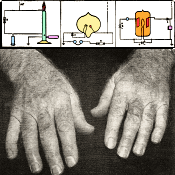 The price of fame and fortune is often fraught
with great tribulations and trials - literally. This eulogy of Audio vacuum tube
inventor
Lee de Forest which was written in 1961 by Radio-Electronics magazine
editor Hugo Gernsback, summarizes many of the great accomplishments of the inventor
/ engineer, but does not mention the battles he fought both to protect his work
from misappropriation by others and to defend himself from accusations of the same.
All the industry greats - Edison, Armstrong, Tesla, Westinghouse, Noyce, Sarnoff,
even Einstein - suffered similar experiences. Mr. Gernsback, a prolific inventor
and publisher himself - was a good personal friend of Dr. de Forest, and
featured his work often over more than three decades through his (Gernsback's) many
trade magazines. A list of many of the articles is at the bottom of this page. If
you are not familiar with the story of how de Forest arrived at his amplifying
Audion tube, please read "How the Audion Was Invented. The journey began with the
use of an open candle flame as a signal detector for CW (continuous wave) signals
in wireless telegraphy. Interestingly, Mr. Gernsback deemed having a close-up photo
of Dr. de Forest's hands was in important piece of the historical record... The price of fame and fortune is often fraught
with great tribulations and trials - literally. This eulogy of Audio vacuum tube
inventor
Lee de Forest which was written in 1961 by Radio-Electronics magazine
editor Hugo Gernsback, summarizes many of the great accomplishments of the inventor
/ engineer, but does not mention the battles he fought both to protect his work
from misappropriation by others and to defend himself from accusations of the same.
All the industry greats - Edison, Armstrong, Tesla, Westinghouse, Noyce, Sarnoff,
even Einstein - suffered similar experiences. Mr. Gernsback, a prolific inventor
and publisher himself - was a good personal friend of Dr. de Forest, and
featured his work often over more than three decades through his (Gernsback's) many
trade magazines. A list of many of the articles is at the bottom of this page. If
you are not familiar with the story of how de Forest arrived at his amplifying
Audion tube, please read "How the Audion Was Invented. The journey began with the
use of an open candle flame as a signal detector for CW (continuous wave) signals
in wireless telegraphy. Interestingly, Mr. Gernsback deemed having a close-up photo
of Dr. de Forest's hands was in important piece of the historical record...
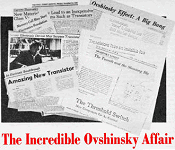 Even with having been granted more than
400 patents in his lifetime, and being a major player in the realms of energy, data
storage, and semiconductor research and manufacturing, you - as well as most people
- have probably never heard the name
Stanford Ovshinsky. He was somewhat of a celebrity in the 1960s and 1970s when
working hard to promote his concept of "glassy semiconductors," - aka Ovonic devices.
Ovonics are amorphous materials that are used for making switches for digital logic
and memory devices. Either the Ovshinsky process did not pan out for high volume
commercial production or some other technology displaced the what it was hoped to
dominate. Not too long ago when watching an episode of original The Man from U.N.C.L.E.
TV series, the Ovshinsky Effect was mentioned by Illya Kuryakin when watching it
after having read this article in a 1969 issue of Electronics Illustrated
magazine... Even with having been granted more than
400 patents in his lifetime, and being a major player in the realms of energy, data
storage, and semiconductor research and manufacturing, you - as well as most people
- have probably never heard the name
Stanford Ovshinsky. He was somewhat of a celebrity in the 1960s and 1970s when
working hard to promote his concept of "glassy semiconductors," - aka Ovonic devices.
Ovonics are amorphous materials that are used for making switches for digital logic
and memory devices. Either the Ovshinsky process did not pan out for high volume
commercial production or some other technology displaced the what it was hoped to
dominate. Not too long ago when watching an episode of original The Man from U.N.C.L.E.
TV series, the Ovshinsky Effect was mentioned by Illya Kuryakin when watching it
after having read this article in a 1969 issue of Electronics Illustrated
magazine...
 Ruh-roh, here is another science news item
sure to memristor denier and über nimrod Tim H.,
who for years sent me harassing e-mails to inform me of how memristors are only
theoretical entities. He got downright abusive and threatening. Maybe someday I'll
reveal his identity ... but I digress. This article from the SciTechDaily website
reports on work done at the University of Southern California. It begins: "Researchers
have made
significant advances in memristor technology, enhancing its precision and efficiency.
This innovation promises to bridge the gap between analog and digital computing,
offering faster, more energy-efficient processing suitable for AI, machine learning,
and beyond..." Ruh-roh, here is another science news item
sure to memristor denier and über nimrod Tim H.,
who for years sent me harassing e-mails to inform me of how memristors are only
theoretical entities. He got downright abusive and threatening. Maybe someday I'll
reveal his identity ... but I digress. This article from the SciTechDaily website
reports on work done at the University of Southern California. It begins: "Researchers
have made
significant advances in memristor technology, enhancing its precision and efficiency.
This innovation promises to bridge the gap between analog and digital computing,
offering faster, more energy-efficient processing suitable for AI, machine learning,
and beyond..."
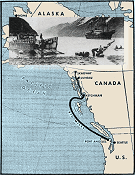 Alaska and Hawaii were added to the Union
as the 49th and 50th states, respectively, in 1959. Prior to that time, both were
referred to as possessions or territories. This story from a 1957 edition of
Radio & Television News refers to Bell Telephone Systems and the U.S. Army
Signal Corps laying the first cable for opening commercial telephone service between
Port Angeles (near Seattle), Washington, and Ketchikan, Territory of Alaska. The
900 mile, submarine cable carried 36 circuits, and took 2 years to install at
a cost of $20 million ($226 million in 2024 money per the BLS). Work conditions
for crews were nowhere near as accommodating or protected against accidents as they
are today. As with so many things, our forebears sacrificed life and limb, literally,
to bring us to the comfortable existence we enjoy today. The men in these and other
vintage photos I post deserve your gratitude... Alaska and Hawaii were added to the Union
as the 49th and 50th states, respectively, in 1959. Prior to that time, both were
referred to as possessions or territories. This story from a 1957 edition of
Radio & Television News refers to Bell Telephone Systems and the U.S. Army
Signal Corps laying the first cable for opening commercial telephone service between
Port Angeles (near Seattle), Washington, and Ketchikan, Territory of Alaska. The
900 mile, submarine cable carried 36 circuits, and took 2 years to install at
a cost of $20 million ($226 million in 2024 money per the BLS). Work conditions
for crews were nowhere near as accommodating or protected against accidents as they
are today. As with so many things, our forebears sacrificed life and limb, literally,
to bring us to the comfortable existence we enjoy today. The men in these and other
vintage photos I post deserve your gratitude...
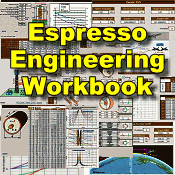 The newest release of RF Cafe's spreadsheet
(Excel) based engineering and science calculator is now available -
Espresso Engineering Workbook™. Among other additions, it now has a Butterworth
Bandpass Calculator, and a Highpass Filter Calculator that does not just gain, but
also phase and group delay! Since 2002,
the original Calculator Workbook has been available as a free download.
Continuing the tradition, RF Cafe Espresso Engineering Workbook™ is
also provided at no cost,
compliments of my generous sponsors. The original calculators are included, but
with a vastly expanded and improved user interface. Error-trapped user input cells
help prevent entry of invalid values. An extensive use of Visual Basic for Applications
(VBA) functions now do most of the heavy lifting with calculations, and facilitates
a wide user-selectable choice of units for voltage, frequency, speed, temperature,
power, wavelength, weight, etc. In fact, a full page of units conversion calculators
is included. A particularly handy feature is the ability to specify the the number
of significant digits to display. Drop-down menus are provided for convenience... The newest release of RF Cafe's spreadsheet
(Excel) based engineering and science calculator is now available -
Espresso Engineering Workbook™. Among other additions, it now has a Butterworth
Bandpass Calculator, and a Highpass Filter Calculator that does not just gain, but
also phase and group delay! Since 2002,
the original Calculator Workbook has been available as a free download.
Continuing the tradition, RF Cafe Espresso Engineering Workbook™ is
also provided at no cost,
compliments of my generous sponsors. The original calculators are included, but
with a vastly expanded and improved user interface. Error-trapped user input cells
help prevent entry of invalid values. An extensive use of Visual Basic for Applications
(VBA) functions now do most of the heavy lifting with calculations, and facilitates
a wide user-selectable choice of units for voltage, frequency, speed, temperature,
power, wavelength, weight, etc. In fact, a full page of units conversion calculators
is included. A particularly handy feature is the ability to specify the the number
of significant digits to display. Drop-down menus are provided for convenience...
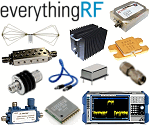 Please take a few moments to visit the
everythingRF website to see how they can assist you with your
project. everythingRF is a product discovery platform for RF and microwave products
and services. They currently have 267,269 products from more than 1397 companies
across 314 categories in their database and enable engineers to search for them
using their customized parametric search tool. Amplifiers, test equipment, power
couplers and dividers, coaxial connectors, waveguide, antennas, filters, mixers,
power supplies, and everything else. Please visit everythingRF today to see how
they can help you. Please take a few moments to visit the
everythingRF website to see how they can assist you with your
project. everythingRF is a product discovery platform for RF and microwave products
and services. They currently have 267,269 products from more than 1397 companies
across 314 categories in their database and enable engineers to search for them
using their customized parametric search tool. Amplifiers, test equipment, power
couplers and dividers, coaxial connectors, waveguide, antennas, filters, mixers,
power supplies, and everything else. Please visit everythingRF today to see how
they can help you.
Thursday the 18th
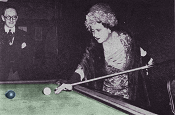 Pardon my self-indulgence here, but in this
world where every idiosyncrasy of every person and/or special interest group and/or
identity group must be accommodated - yea, even celebrated and accorded special
privileges - why is it that we
left-handers, south-paws, leftys, gawk-handers - call us what you may - to this
day are forced to adopt the practices and implements of right-handers? If a left-handed
version of a keyboard (number keys on left), a pair of scissors, notebooks with
hinging on the right, mugs with handle to the right of design, tape measures that
extend to the left with numbers right-side up, etc., it usually costs more. Speaking
of reparations (were we?), while many of the aforementioned entities are claiming
a right to reparations for past injustices regardless of whether the claimant ever
personally suffered from it, why shouldn't leftys, who historically have been forced
to adopt and adapt to the righty's world, and even punished for resistance or inability,
also now be financially compensated for the indignances? A few years ago I would
have asked for a cool million dollars, but with the hyperinflation of late, I need
$1.19M
today. In cash, and tax-free... Pardon my self-indulgence here, but in this
world where every idiosyncrasy of every person and/or special interest group and/or
identity group must be accommodated - yea, even celebrated and accorded special
privileges - why is it that we
left-handers, south-paws, leftys, gawk-handers - call us what you may - to this
day are forced to adopt the practices and implements of right-handers? If a left-handed
version of a keyboard (number keys on left), a pair of scissors, notebooks with
hinging on the right, mugs with handle to the right of design, tape measures that
extend to the left with numbers right-side up, etc., it usually costs more. Speaking
of reparations (were we?), while many of the aforementioned entities are claiming
a right to reparations for past injustices regardless of whether the claimant ever
personally suffered from it, why shouldn't leftys, who historically have been forced
to adopt and adapt to the righty's world, and even punished for resistance or inability,
also now be financially compensated for the indignances? A few years ago I would
have asked for a cool million dollars, but with the hyperinflation of late, I need
$1.19M
today. In cash, and tax-free...
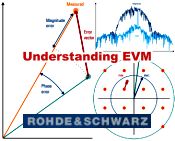 Rhode & Schwarz publishes a lot of very
useful application notes that are particularly for newcomers to the field of RF
and microwaves. All are forms of infomercials for their products, but than all companies
do it. This new one entitled, "Understanding
EVM," provides "...an introduction to error vector magnitude (EVM), which is
the primary metric of modulation accuracy. This paper is divided into three sections.
The first section discusses the fundamentals of the digital modulation schemes used
in modern radio frequency communications systems, in particular, APSK and QAM. The
second section discusses the fundamentals of error vector magnitude. This section
not only defines EVM, but also discusses the most common sources of EVM, how EVM
is measured, and the effects of EVM. The final section explains the basics of constellation
diagrams and how constellation diagrams can often be used to diagnose or troubleshoot
the common root causes of EVM. EVM is measured at each symbol time, and larger values
of EVM indicate greater distance between..." Rhode & Schwarz publishes a lot of very
useful application notes that are particularly for newcomers to the field of RF
and microwaves. All are forms of infomercials for their products, but than all companies
do it. This new one entitled, "Understanding
EVM," provides "...an introduction to error vector magnitude (EVM), which is
the primary metric of modulation accuracy. This paper is divided into three sections.
The first section discusses the fundamentals of the digital modulation schemes used
in modern radio frequency communications systems, in particular, APSK and QAM. The
second section discusses the fundamentals of error vector magnitude. This section
not only defines EVM, but also discusses the most common sources of EVM, how EVM
is measured, and the effects of EVM. The final section explains the basics of constellation
diagrams and how constellation diagrams can often be used to diagnose or troubleshoot
the common root causes of EVM. EVM is measured at each symbol time, and larger values
of EVM indicate greater distance between..."
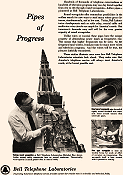 According to this full-page advertisement
in the June 1955 issue of Radio & Television News magazine, Bell Telephone
Laboratories was responsible for designing and fielding "waveguide
pipe," aka flexible circular waveguides. According to other historical sources,
both George Southworth of Bell Telephone Laboratories and Wilmer Barrow of the Massachusetts
Institute of Technology (M.I.T.) independently and simultaneously developed circular
waveguide, but the early devices were rigid pipe rather than being fabricated from
tightly wrapped, insulated wire that permitted it to be bent rather than requiring
separate corner and offset pieces. Insertion loss and VSWR is typically not as good
as with rigid waveguide, but the ease of installation in many situations justifies
the poorer electrical performance. Bell Telephone Laboratories was responsible for
a huge number of breakthrough and paradigm-changing discoveries prior to being broken
into parts (Regional Bell Operating Companies, aka Baby Bells) in 1984 due to an
antitrust lawsuit... According to this full-page advertisement
in the June 1955 issue of Radio & Television News magazine, Bell Telephone
Laboratories was responsible for designing and fielding "waveguide
pipe," aka flexible circular waveguides. According to other historical sources,
both George Southworth of Bell Telephone Laboratories and Wilmer Barrow of the Massachusetts
Institute of Technology (M.I.T.) independently and simultaneously developed circular
waveguide, but the early devices were rigid pipe rather than being fabricated from
tightly wrapped, insulated wire that permitted it to be bent rather than requiring
separate corner and offset pieces. Insertion loss and VSWR is typically not as good
as with rigid waveguide, but the ease of installation in many situations justifies
the poorer electrical performance. Bell Telephone Laboratories was responsible for
a huge number of breakthrough and paradigm-changing discoveries prior to being broken
into parts (Regional Bell Operating Companies, aka Baby Bells) in 1984 due to an
antitrust lawsuit...
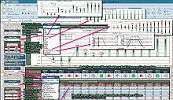 RF Cascade Workbook is the next phase in the evolution of RF Cafe's long-running
series, RF Cascade Workbook. Chances are you have never used a spreadsheet
quite like this (click
here for screen capture). It is a full-featured RF system cascade parameter
and frequency planner that includes filters and mixers for a mere $45. Built in
MS Excel, using RF Cascade Workbook is a cinch and the format
is entirely customizable. It is significantly easier and faster than using a multi-thousand
dollar simulator when a high level system analysis is all that is needed...
RF Cascade Workbook is the next phase in the evolution of RF Cafe's long-running
series, RF Cascade Workbook. Chances are you have never used a spreadsheet
quite like this (click
here for screen capture). It is a full-featured RF system cascade parameter
and frequency planner that includes filters and mixers for a mere $45. Built in
MS Excel, using RF Cascade Workbook is a cinch and the format
is entirely customizable. It is significantly easier and faster than using a multi-thousand
dollar simulator when a high level system analysis is all that is needed...
Wednesday the 17th
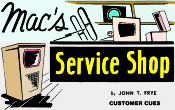 In 1958 when this "Customer Cues" installment
of John T. Frye's "Mac's
Service Shop" series of technodramas in Radio & TV News magazine, color
television was a relatively new phenomenon. The first commercially sold color TV
set - the Admiral C1617A - went on sale at the very end of 1953. The NTSC approved
the first standardized specification for a composite color television composite
signal (color, gray scale, audio, brightness, synchronization) earlier that year.
It allowed the same signal to work with both black and white (B&W) and color
receivers. A lot of research went into making sure the viewing public was happy
with their sets, using polls, hands-on instruction and publications on how to properly
adjust tuning and picture controls, plus tips on installing outdoor antennas and
running the twin lead transmission cable down to the set. Of course the proper way
to fiddle with the built-in "rabbit ears" antenna was covered as well. I don't think
any official pamphlets included mashing tinfoil onto the rabbit ears in complex
patterns as many people did - truth is, it must have worked in some cases. In the
story, Mac schools Barney on the situation. In 1958 when this "Customer Cues" installment
of John T. Frye's "Mac's
Service Shop" series of technodramas in Radio & TV News magazine, color
television was a relatively new phenomenon. The first commercially sold color TV
set - the Admiral C1617A - went on sale at the very end of 1953. The NTSC approved
the first standardized specification for a composite color television composite
signal (color, gray scale, audio, brightness, synchronization) earlier that year.
It allowed the same signal to work with both black and white (B&W) and color
receivers. A lot of research went into making sure the viewing public was happy
with their sets, using polls, hands-on instruction and publications on how to properly
adjust tuning and picture controls, plus tips on installing outdoor antennas and
running the twin lead transmission cable down to the set. Of course the proper way
to fiddle with the built-in "rabbit ears" antenna was covered as well. I don't think
any official pamphlets included mashing tinfoil onto the rabbit ears in complex
patterns as many people did - truth is, it must have worked in some cases. In the
story, Mac schools Barney on the situation.
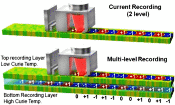 "Research groups from NIMS, Seagate Technology,
and Tohoku University have made a breakthrough in the field of hard disk drives
(HDD) by demonstrating the feasibility of multi-level recording using a
three-dimensional magnetic recording medium to store digital information. The
research groups have shown that this technology can be used to increase the storage
capacity of HDDs, which could lead to more efficient and cost-effective data storage
solutions in the future. Enhancing Data Storage Capacity Data centers are increasingly
storing vast amounts of data on hard disk drives (HDDs) that use perpendicular magnetic
recording (PMR) to store information at areal densities of around 1.5 Tbit/in².
However, to transition to higher areal densities, a high anisotropy magnetic recording
medium consisting of FePt grains combined with heat-assisted laser writing is required.
This method, known as heat-assisted magnetic recording (HAMR), is capable of sustaining
areal recording densities of up to 10 Tbit/in². Furthermore, densities of larger
than 10 Tbit/in² are possible based on a new principle demonstrated by storing multiple
recording levels of 3 or 4 compared..." "Research groups from NIMS, Seagate Technology,
and Tohoku University have made a breakthrough in the field of hard disk drives
(HDD) by demonstrating the feasibility of multi-level recording using a
three-dimensional magnetic recording medium to store digital information. The
research groups have shown that this technology can be used to increase the storage
capacity of HDDs, which could lead to more efficient and cost-effective data storage
solutions in the future. Enhancing Data Storage Capacity Data centers are increasingly
storing vast amounts of data on hard disk drives (HDDs) that use perpendicular magnetic
recording (PMR) to store information at areal densities of around 1.5 Tbit/in².
However, to transition to higher areal densities, a high anisotropy magnetic recording
medium consisting of FePt grains combined with heat-assisted laser writing is required.
This method, known as heat-assisted magnetic recording (HAMR), is capable of sustaining
areal recording densities of up to 10 Tbit/in². Furthermore, densities of larger
than 10 Tbit/in² are possible based on a new principle demonstrated by storing multiple
recording levels of 3 or 4 compared..."
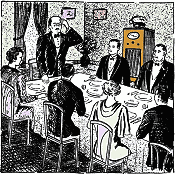 Mystery stories were broadcast on radio
stations in the days before television - and for quite a while after TV was available
for that matter. Families gathered around the living room radio set in excited anticipation
of the next adventure of shows like "The Shadow," "Amos 'n' Andy," "Tales of the
Texas Rangers," "Dragnet," and "The Green Hornet." During that era, it was common
also for electronics magazines, which focused largely on radio communications, to
experiment with printed
dramas that had a radio-centric theme. Here is the first of a series tried by
Radio-Craft magazine in the late 1930s. A couple decades later the "Carl &
Jerry" adventures were run in Popular Electronics, but other than that
I don't recall seeing a lot of these things. If you're a mystery fan, then here
you go. A great collection of old time radio broadcasts can be heard on the Old
Radio World and Old Radio Programs websites... Mystery stories were broadcast on radio
stations in the days before television - and for quite a while after TV was available
for that matter. Families gathered around the living room radio set in excited anticipation
of the next adventure of shows like "The Shadow," "Amos 'n' Andy," "Tales of the
Texas Rangers," "Dragnet," and "The Green Hornet." During that era, it was common
also for electronics magazines, which focused largely on radio communications, to
experiment with printed
dramas that had a radio-centric theme. Here is the first of a series tried by
Radio-Craft magazine in the late 1930s. A couple decades later the "Carl &
Jerry" adventures were run in Popular Electronics, but other than that
I don't recall seeing a lot of these things. If you're a mystery fan, then here
you go. A great collection of old time radio broadcasts can be heard on the Old
Radio World and Old Radio Programs websites...
 RF Cafe visitor James G. sent me photos
of some paper capacitors he plans to replace in a 1950s vintage radio set. It is
a foreign job, most likely from France, based on the schematic. Some markings on
the capacitors are not familiar; maybe you have seen them. RF Cafe visitor James G. sent me photos
of some paper capacitors he plans to replace in a 1950s vintage radio set. It is
a foreign job, most likely from France, based on the schematic. Some markings on
the capacitors are not familiar; maybe you have seen them.
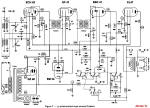 The photos show things like "ESSAI 1.500
V.C.C." which I assume means 1,500 V (1.5 kV) working voltage, based on
the European swapping of dots and commas for decimal points. "Essai" in French means
"test," or "trial." "V.C.C." is probably a French marking for voltage similar to
WVDC (DC working voltage). Another marking shows "100/1000 de The photos show things like "ESSAI 1.500
V.C.C." which I assume means 1,500 V (1.5 kV) working voltage, based on
the European swapping of dots and commas for decimal points. "Essai" in French means
"test," or "trial." "V.C.C." is probably a French marking for voltage similar to
WVDC (DC working voltage). Another marking shows "100/1000 de F," which could be μμF,
but unlikely given it is a paper capacitor. Maybe millifarad? Any insight will be
appreciated. F," which could be μμF,
but unlikely given it is a paper capacitor. Maybe millifarad? Any insight will be
appreciated.
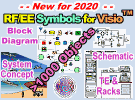 With more than 1000
custom-built symbols, this has got to be the most comprehensive set of
Visio Symbols
available for RF, analog, and digital system and schematic drawings! Every object
has been built to fit proportionally on the provided A-, B- and C-size drawing page
templates (or can use your own). Symbols are provided for equipment racks and test
equipment, system block diagrams, conceptual drawings, and schematics. Unlike previous
versions, these are NOT Stencils, but instead are all contained on tabbed pages
within a single Visio document. That puts everything in front of you in its full
glory. Just copy and paste what you need on your drawing... With more than 1000
custom-built symbols, this has got to be the most comprehensive set of
Visio Symbols
available for RF, analog, and digital system and schematic drawings! Every object
has been built to fit proportionally on the provided A-, B- and C-size drawing page
templates (or can use your own). Symbols are provided for equipment racks and test
equipment, system block diagrams, conceptual drawings, and schematics. Unlike previous
versions, these are NOT Stencils, but instead are all contained on tabbed pages
within a single Visio document. That puts everything in front of you in its full
glory. Just copy and paste what you need on your drawing...
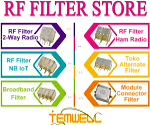 Temwell is a manufacturer of 5G wireless communications filters
for aerospace, satellite communication, AIoT, 5G networking, IoV, drone, mining
transmission, IoT, medical, military, laboratory, transportation, energy, broadcasting
(CATV), and etc. An RF helical bandpass specialist since 1994, we have posted >5,000
completed spec sheets online for all kinds of RF filters including helical, cavity,
LC, and SMD. Standard highpass, lowpass, bandpass, and bandstop, as well as duplexer/diplexer,
multiplexer. Also RF combiners, splitters, power dividers, attenuators, circulators,
couplers, PA, LNA, and obsolete coil & inductor solutions. Temwell is a manufacturer of 5G wireless communications filters
for aerospace, satellite communication, AIoT, 5G networking, IoV, drone, mining
transmission, IoT, medical, military, laboratory, transportation, energy, broadcasting
(CATV), and etc. An RF helical bandpass specialist since 1994, we have posted >5,000
completed spec sheets online for all kinds of RF filters including helical, cavity,
LC, and SMD. Standard highpass, lowpass, bandpass, and bandstop, as well as duplexer/diplexer,
multiplexer. Also RF combiners, splitters, power dividers, attenuators, circulators,
couplers, PA, LNA, and obsolete coil & inductor solutions.
Tuesday the 16th
 Here is a really good synopsis of
"rare earth" elements that explains how they came to be known in that way. Hint:
It is not that they are so rare, in fact per Wikipedia, Cerium is the 25th most
abundant element on Earth. The issue is they are not in concentrated lodes, but
spread out as components of other mineral compounds, so extensive processing is
needed to isolate and purify them. One of the first post-war commercial level extraction
processes was the result of experimentations during nuclear bomb research. As you
might know, "holes" existed in the Periodic Table of the Elements when it was first
constructed in 1869 by Dmitri Mendeleev, because not all predicted naturally occurring
elements had been found. Helium, atomic number 2, was not found on Earth until 1895,
after first having been observed in the sun's spectrum a few years earlier (hence
its name, from Helios). Author Alden Armagnac provides a primer in the original
15 rare earths (now 17) in this 1949 Popular Science magazine article... Here is a really good synopsis of
"rare earth" elements that explains how they came to be known in that way. Hint:
It is not that they are so rare, in fact per Wikipedia, Cerium is the 25th most
abundant element on Earth. The issue is they are not in concentrated lodes, but
spread out as components of other mineral compounds, so extensive processing is
needed to isolate and purify them. One of the first post-war commercial level extraction
processes was the result of experimentations during nuclear bomb research. As you
might know, "holes" existed in the Periodic Table of the Elements when it was first
constructed in 1869 by Dmitri Mendeleev, because not all predicted naturally occurring
elements had been found. Helium, atomic number 2, was not found on Earth until 1895,
after first having been observed in the sun's spectrum a few years earlier (hence
its name, from Helios). Author Alden Armagnac provides a primer in the original
15 rare earths (now 17) in this 1949 Popular Science magazine article...
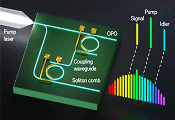 "Columbia Engineering researchers have built
a photonic chip that can produce
high-quality, ultra-low-noise microwave signals using only a single laser. The
compact device - a chip so small, it could fit on a sharp pencil point - results
in the lowest microwave noise ever observed in an integrated photonics platform.
The achievement provides a promising pathway towards small-footprint ultra-low-noise
microwave generation for applications such as high-speed communication, atomic clocks,
and autonomous vehicles. Electronic devices for global navigation, wireless communications,
radar, and precision timing need stable microwave sources to serve as clocks and
information carriers. A key aspect to increasing the performance of these devices
is reducing the noise, or random fluctuations in phase, that is present on the microwave.
'In the past decade, a technique known as optical frequency division has resulted
in the lowest noise microwave signals that have been generated to date,' said Alexander
Gaeta, David M. Rickey Professor of Applied Physics and Materials Science and professor
of electrical engineering at Columbia Engineering..." "Columbia Engineering researchers have built
a photonic chip that can produce
high-quality, ultra-low-noise microwave signals using only a single laser. The
compact device - a chip so small, it could fit on a sharp pencil point - results
in the lowest microwave noise ever observed in an integrated photonics platform.
The achievement provides a promising pathway towards small-footprint ultra-low-noise
microwave generation for applications such as high-speed communication, atomic clocks,
and autonomous vehicles. Electronic devices for global navigation, wireless communications,
radar, and precision timing need stable microwave sources to serve as clocks and
information carriers. A key aspect to increasing the performance of these devices
is reducing the noise, or random fluctuations in phase, that is present on the microwave.
'In the past decade, a technique known as optical frequency division has resulted
in the lowest noise microwave signals that have been generated to date,' said Alexander
Gaeta, David M. Rickey Professor of Applied Physics and Materials Science and professor
of electrical engineering at Columbia Engineering..."
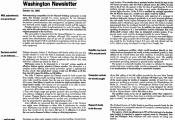 1965 was the beginning of America's involvement
in Vietnam. A mere decade had passed since the end of the Korean War (or "conflict"
if you prefer), and the Department of Defense had not done much to modernize the
military since then. Unlike with World War II when U.S. factories were turning
out military aircraft, ships, and ground vehicles ahead of formal involvement, Congress
was not interested in making headlines with news of war machines. When the first
U.S. troops were sent in March of that year, things kicked into high gear. Lyndon
Johnson was said to have tried to direct the war from the White House, but it was
his Secretary of Defense, Robert McNamara, whose actions caused the Vietnam efforts
to be nicknamed "McNamara's War." The "Washington
Newsletter" feature of this October 1965 issue of Electronics magazine
reported on, among other military-related items, the U.S. Air Force's plans to phase
out the venerated (now, not then) B−52 Stratofortress bomber by sometime in the
1970s... 1965 was the beginning of America's involvement
in Vietnam. A mere decade had passed since the end of the Korean War (or "conflict"
if you prefer), and the Department of Defense had not done much to modernize the
military since then. Unlike with World War II when U.S. factories were turning
out military aircraft, ships, and ground vehicles ahead of formal involvement, Congress
was not interested in making headlines with news of war machines. When the first
U.S. troops were sent in March of that year, things kicked into high gear. Lyndon
Johnson was said to have tried to direct the war from the White House, but it was
his Secretary of Defense, Robert McNamara, whose actions caused the Vietnam efforts
to be nicknamed "McNamara's War." The "Washington
Newsletter" feature of this October 1965 issue of Electronics magazine
reported on, among other military-related items, the U.S. Air Force's plans to phase
out the venerated (now, not then) B−52 Stratofortress bomber by sometime in the
1970s...
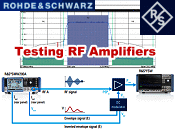 Rhode & Schwarz publishes a lot of very
useful application notes that are particularly for newcomers to the field of RF
and microwaves. All are forms of infomercials for their products, but than all companies
do it. This new one entitled, "Testing
RF Amplifier Designs," "...offers an overview from electronic design automation
to real RF devices while focusing on verification, characterization, repeatability,
and throughput. It explains the important characteristics and how they can be verified.
In addition, it sheds light on the specialties along the value chain from development,
validation and characterization to production." Here is a link to
Testing RF Amplifier Designs that doesn't require registration... Rhode & Schwarz publishes a lot of very
useful application notes that are particularly for newcomers to the field of RF
and microwaves. All are forms of infomercials for their products, but than all companies
do it. This new one entitled, "Testing
RF Amplifier Designs," "...offers an overview from electronic design automation
to real RF devices while focusing on verification, characterization, repeatability,
and throughput. It explains the important characteristics and how they can be verified.
In addition, it sheds light on the specialties along the value chain from development,
validation and characterization to production." Here is a link to
Testing RF Amplifier Designs that doesn't require registration...
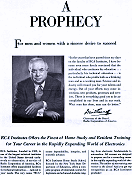 In the original radio broadcast of Jean
Shepherd's "A Christmas Story," which was set in the Great Depression era, he spoke
of magazine advertisements promising rewarding careers in electronics for men of
adventure. Over the last few years I have posted many such advertisements from vintage
electronics magazines, but they were also commonly seen in women's magazines,
Life, The Saturday Evening Post, and many others. This ad pitching
the Radio Corporation of America's (RCA) home study courses for electronics technology
ran in a 1961 edition of Electronics World. Chairman of the Board,
David Sarnoff, sends the message to readers. Sarnoff was commissioned as a Brigadier
General in the Army Air Corps during World War II. He orchestrated radio broadcasts
for the D−Day invasion (June 6, 1944), and also the Radio Free Europe system for
post-war years... In the original radio broadcast of Jean
Shepherd's "A Christmas Story," which was set in the Great Depression era, he spoke
of magazine advertisements promising rewarding careers in electronics for men of
adventure. Over the last few years I have posted many such advertisements from vintage
electronics magazines, but they were also commonly seen in women's magazines,
Life, The Saturday Evening Post, and many others. This ad pitching
the Radio Corporation of America's (RCA) home study courses for electronics technology
ran in a 1961 edition of Electronics World. Chairman of the Board,
David Sarnoff, sends the message to readers. Sarnoff was commissioned as a Brigadier
General in the Army Air Corps during World War II. He orchestrated radio broadcasts
for the D−Day invasion (June 6, 1944), and also the Radio Free Europe system for
post-war years...
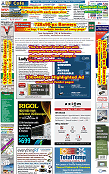 Banner Ads are rotated in all locations
on the page! RF Cafe typically receives 8,000-15,000 visits each
weekday. RF Cafe
is a favorite of engineers, technicians, hobbyists, and students all over the world.
With more than 17,000 pages in the Google search index, RF Cafe returns in
favorable positions on many types of key searches, both for text and images.
Your Banner Ads are displayed on average 280,000 times per year! New content
is added on a daily basis, which keeps the major search engines interested enough
to spider it multiple times each day. Items added on the homepage often can be found
in a Google search within a few hours of being posted. If you need your company
news to be seen, RF Cafe is the place to be... Banner Ads are rotated in all locations
on the page! RF Cafe typically receives 8,000-15,000 visits each
weekday. RF Cafe
is a favorite of engineers, technicians, hobbyists, and students all over the world.
With more than 17,000 pages in the Google search index, RF Cafe returns in
favorable positions on many types of key searches, both for text and images.
Your Banner Ads are displayed on average 280,000 times per year! New content
is added on a daily basis, which keeps the major search engines interested enough
to spider it multiple times each day. Items added on the homepage often can be found
in a Google search within a few hours of being posted. If you need your company
news to be seen, RF Cafe is the place to be...
Monday the 15th
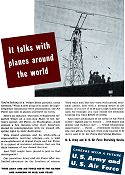 The U.S. Air Force became a separate branch
of the armed forces on September 18th, 1947, almost exactly two years after Japan
unconditionally surrendered to Allied Forces (Germany had unconditionally surrendered
back in May). This recruitment advertisement appeared in the March 1948 issue of
Popular Science magazine, a year after the Selective Training and Service Act of
1940 expired on March 31st, 1947. It was a joint appeal by the Army and the Air
Force for men seeking careers in communications - particularly targeting, it seems,
amateur radio operators, by touting a steerable beam antenna. I could not find numbers
on how many conscripted and volunteer troops left the service immediately after
the war. Many articles reported a big force drawdown in personnel, which combined
with massive layoffs in war equipment industries, led to employment problems. It
did not last for long, as the Military Selective Service Act of 1948 reinstated
draft registration again. After all, the Military Industrial Complex, as 5-star
General/President Eisenhower would eventually call it, needed work. The U.S. Air Force became a separate branch
of the armed forces on September 18th, 1947, almost exactly two years after Japan
unconditionally surrendered to Allied Forces (Germany had unconditionally surrendered
back in May). This recruitment advertisement appeared in the March 1948 issue of
Popular Science magazine, a year after the Selective Training and Service Act of
1940 expired on March 31st, 1947. It was a joint appeal by the Army and the Air
Force for men seeking careers in communications - particularly targeting, it seems,
amateur radio operators, by touting a steerable beam antenna. I could not find numbers
on how many conscripted and volunteer troops left the service immediately after
the war. Many articles reported a big force drawdown in personnel, which combined
with massive layoffs in war equipment industries, led to employment problems. It
did not last for long, as the Military Selective Service Act of 1948 reinstated
draft registration again. After all, the Military Industrial Complex, as 5-star
General/President Eisenhower would eventually call it, needed work.
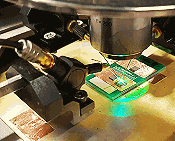 "As transistors are made ever tinier to
fit more computing power into a smaller footprint, they bump up against a big problem:
quantum mechanics. Electrons get jumpy in small devices and leak out, which wastes
energy while degrading performance. Now a team of researchers is showing that it
doesn't have to be that way. With careful engineering, it's possible to turn electrons'
quantum behavior into an advantage. A team of English, Canadian, and Italian researchers
have developed a
single-molecule
transistor that harnesses quantum effects. At low temperatures, the single-molecule
device shows a strong change in current with only a small change in gate voltage,
nearing a physical limit known as the sub-threshold swing. Getting near or beyond
this limit will allow transistors to be switched with lower voltages, making them
more efficient and generating less waste heat. The research team, including physicists
at Queen Mary University of London, achieved this by taking advantage of how quantum
interference alters the flow of current in single molecules..." "As transistors are made ever tinier to
fit more computing power into a smaller footprint, they bump up against a big problem:
quantum mechanics. Electrons get jumpy in small devices and leak out, which wastes
energy while degrading performance. Now a team of researchers is showing that it
doesn't have to be that way. With careful engineering, it's possible to turn electrons'
quantum behavior into an advantage. A team of English, Canadian, and Italian researchers
have developed a
single-molecule
transistor that harnesses quantum effects. At low temperatures, the single-molecule
device shows a strong change in current with only a small change in gate voltage,
nearing a physical limit known as the sub-threshold swing. Getting near or beyond
this limit will allow transistors to be switched with lower voltages, making them
more efficient and generating less waste heat. The research team, including physicists
at Queen Mary University of London, achieved this by taking advantage of how quantum
interference alters the flow of current in single molecules..."
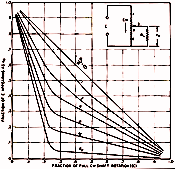 Here in this 1967 issue of Electronics
World magazine is yet another example of where the basics in electronics never
changes. There are always new people entering into the realm, so even if the subject
has been covered countless times already, there is always a need to print it again.
Remember that at one time you were a newbie and appreciated seeing beginners' concepts
explained. The old-timers of the day probably complained about being tired of seeing
the simple stuff re-hashed over and over. Most standard
potentiometers (pots) are linear in operation, that is, the resistance between
the moveable wiper contact and the overall resistance between the two ends is directly
proportional to the percentage of travel along the length of the resistive element
(printed or wirewound). One of more popular specialty pots is the logarithmically
tapered type that is used in audio circuits in order to effect an audible linear
sound volume change relative to the percentage of travel of the wiper arm. Analog
stereo systems are major users of tapered potentiometers. The more things change,
the more they remain the same... Here in this 1967 issue of Electronics
World magazine is yet another example of where the basics in electronics never
changes. There are always new people entering into the realm, so even if the subject
has been covered countless times already, there is always a need to print it again.
Remember that at one time you were a newbie and appreciated seeing beginners' concepts
explained. The old-timers of the day probably complained about being tired of seeing
the simple stuff re-hashed over and over. Most standard
potentiometers (pots) are linear in operation, that is, the resistance between
the moveable wiper contact and the overall resistance between the two ends is directly
proportional to the percentage of travel along the length of the resistive element
(printed or wirewound). One of more popular specialty pots is the logarithmically
tapered type that is used in audio circuits in order to effect an audible linear
sound volume change relative to the percentage of travel of the wiper arm. Analog
stereo systems are major users of tapered potentiometers. The more things change,
the more they remain the same...
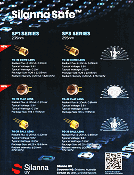 When's the last time you saw a magazine
advertisement showing electronic devices in
TO- type metal packages?
"TO," by the way, stands for "transistor outline." It's been a long time for me.
I did a double-take upon spotting this full-page ad by
Silanna UV appeared in the April issue of
Photonics. The
products encased in the those vintage metal cans are ultraviolet light emitting
diodes (UV LED), which are used primarily in sterilization processes for killing
bacteria and viruses. Per the company website, 'Our best-in-class UV LED technologies
can address everything from reducing healthcare-acquired infections and food contamination
to minimizing the transmission of diseases and removing micro pollutants from drinking
water. And in creating these products, Silanna focuses on minimizing its own use
of natural resources and energy through innovative approaches to 'designing for
manufacture' and investing in the latest, optimized production processes.'" That's
it; I thought you might enjoy a trip back in time, a la the old
Watkins Johnson, M/A-COM, and Avantek RF amps and mixers. When's the last time you saw a magazine
advertisement showing electronic devices in
TO- type metal packages?
"TO," by the way, stands for "transistor outline." It's been a long time for me.
I did a double-take upon spotting this full-page ad by
Silanna UV appeared in the April issue of
Photonics. The
products encased in the those vintage metal cans are ultraviolet light emitting
diodes (UV LED), which are used primarily in sterilization processes for killing
bacteria and viruses. Per the company website, 'Our best-in-class UV LED technologies
can address everything from reducing healthcare-acquired infections and food contamination
to minimizing the transmission of diseases and removing micro pollutants from drinking
water. And in creating these products, Silanna focuses on minimizing its own use
of natural resources and energy through innovative approaches to 'designing for
manufacture' and investing in the latest, optimized production processes.'" That's
it; I thought you might enjoy a trip back in time, a la the old
Watkins Johnson, M/A-COM, and Avantek RF amps and mixers.
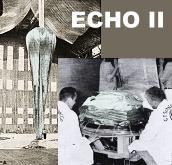 A love-hate relationship between major nations
competing for leadership and dominance in the military and aerospace technology
realms has existed in earnest at least since the
space race began. Often, the pilots, astronauts, scientists and engineers are
much more willing to set aside political differences in order to more effectively
and efficiently advance the state of the art and/or basic knowledge. Maybe archeologists,
biologists, endocrinologists, climatologists, zoologists, pathologists, and you-name-it-ologists
feel the same way, but those types, dealing with squishy living things, are probably
more altruistic than your typical physical sciences guy (or gal). It is the government
management sides of the equation agonizing over the need to solicit or accept foreign
assistance. There is (or was at the time) no better example than the U.S.A. (United
States of America) and the U.S.S.R. (Union of Soviet Socialist Republics), particularly
for space-based communications. Satellites were a very new entry into the radio
world and both sides needed each other's help in testing and assessing the few "birds"
being launched. In particular, high gain earth-based receiver systems were required... A love-hate relationship between major nations
competing for leadership and dominance in the military and aerospace technology
realms has existed in earnest at least since the
space race began. Often, the pilots, astronauts, scientists and engineers are
much more willing to set aside political differences in order to more effectively
and efficiently advance the state of the art and/or basic knowledge. Maybe archeologists,
biologists, endocrinologists, climatologists, zoologists, pathologists, and you-name-it-ologists
feel the same way, but those types, dealing with squishy living things, are probably
more altruistic than your typical physical sciences guy (or gal). It is the government
management sides of the equation agonizing over the need to solicit or accept foreign
assistance. There is (or was at the time) no better example than the U.S.A. (United
States of America) and the U.S.S.R. (Union of Soviet Socialist Republics), particularly
for space-based communications. Satellites were a very new entry into the radio
world and both sides needed each other's help in testing and assessing the few "birds"
being launched. In particular, high gain earth-based receiver systems were required...
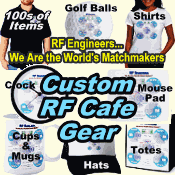 This assortment of custom-designed themes
by RF Cafe includes T-Shirts, Mouse Pads, Clocks, Tote Bags, Coffee Mugs and Steins,
Purses, Sweatshirts, Baseball Caps, and more, all sporting my amazingly clever "RF Engineers - We Are the World's
Matchmakers" Smith chart design. These would make excellent gifts for husbands,
wives, kids, significant others, and for handing out at company events or as rewards
for excellent service. My graphic has been ripped off by other people and used on
their products, so please be sure to purchase only official RF Cafe gear. I only
make a couple bucks on each sale - the rest goes to Cafe Press. It's a great way
to help support RF Cafe. Thanks... This assortment of custom-designed themes
by RF Cafe includes T-Shirts, Mouse Pads, Clocks, Tote Bags, Coffee Mugs and Steins,
Purses, Sweatshirts, Baseball Caps, and more, all sporting my amazingly clever "RF Engineers - We Are the World's
Matchmakers" Smith chart design. These would make excellent gifts for husbands,
wives, kids, significant others, and for handing out at company events or as rewards
for excellent service. My graphic has been ripped off by other people and used on
their products, so please be sure to purchase only official RF Cafe gear. I only
make a couple bucks on each sale - the rest goes to Cafe Press. It's a great way
to help support RF Cafe. Thanks...
These archive pages are provided in order to make it easier for you to find items
that you remember seeing on the RF Cafe homepage. Of course probably the easiest
way to find anything on the website is to use the "Search
RF Cafe" box at the top of every page.
About RF Cafe.
Homepage Archive Pages
2024:
Jan |
Feb |
Mar |
Apr |
May |
Jun |
Jul |
Aug |
Sep |
Oct |
Nov |
Dec
2023:
Jan |
Feb |
Mar |
Apr |
May |
Jun |
Jul |
Aug |
Sep |
Oct |
Nov |
Dec
2022:
Jan |
Feb |
Mar |
Apr |
May |
Jun |
Jul |
Aug |
Sep |
Oct |
Nov |
Dec
2021:
Jan |
Feb |
Mar |
Apr |
May |
Jun |
Jul |
Aug |
Sep |
Oct |
Nov |
Dec
2020:
Jan |
Feb |
Mar |
Apr |
May |
Jun |
Jul |
Aug |
Sep |
Oct |
Nov |
Dec
2019:
Jan |
Feb |
Mar |
Apr |
May |
Jun |
Jul |
Aug |
Sep |
Oct |
Nov |
Dec
2018:
Jan |
Feb |
Mar |
Apr |
May |
Jun |
Jul |
Aug |
Sep |
Oct |
Nov |
Dec
2017:
Jan | Feb |
Mar |
Apr |
May |
Jun |
Jul |
Aug |
Sep |
Oct |
Nov |
Dec
2016:
Jan |
Feb |
Mar |
Apr |
May |
Jun |
Jul |
Aug |
Sep |
Oct |
Nov |
Dec
2015:
Jan |
Feb |
Mar |
Apr |
May |
Jun |
Jul |
Aug |
Sep |
Oct |
Nov |
Dec
2014:
Jan |
Feb |
Mar |
Apr |
May |
Jun |
Jul |
Aug |
Sep |
Oct |
Nov |
Dec
2013:
Jan |
Feb |
Mar |
Apr |
May |
Jun |
Jul |
Aug |
Sep |
Oct |
Nov |
Dec
2012:
1 |
2 |
3 |
4 |
5 |
6 |
7 |
8 |
9 |
10 |
11 |
12 |
13 (no archives before 2012)
|















 F," which could be μμF,
but unlikely given it is a paper capacitor. Maybe millifarad? Any insight will be
appreciated.
F," which could be μμF,
but unlikely given it is a paper capacitor. Maybe millifarad? Any insight will be
appreciated.












